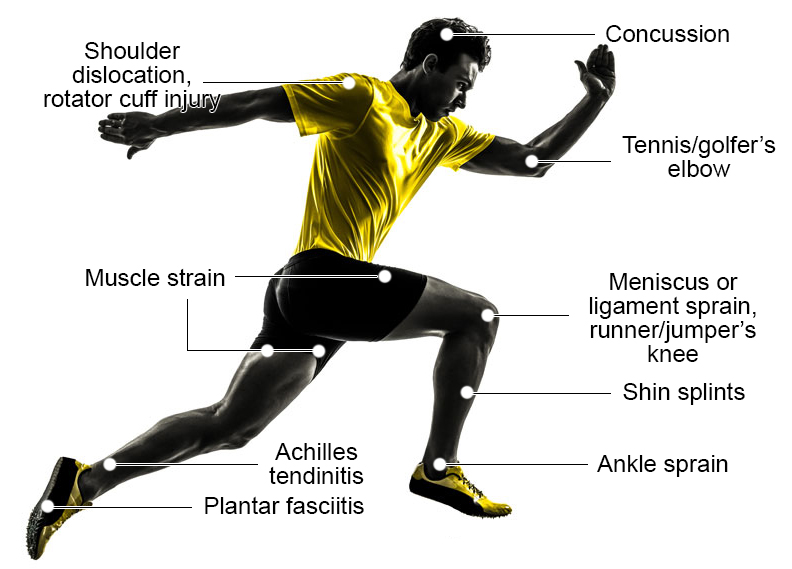According to Wiarton Willie's prediction, spring is coming early. The arrival of spring brings with it plenty of sports, activities, and unfortunately, injuries. The average Canadian lives a pretty sedentary lifestyle, so suddenly playing 36 holes or running 10k or being a weekend warrior can take its toll. Most sports-related injuries are soft tissue injuries. Read on to find out more about these injuries.
Sprains and Strains
These are probably the most common types of sports-related injuries. Sprains refer to injuries to ligaments, while strains refer to injuries to muscles or tendons. Suddenly stretching ligaments (sprains) or muscle fibers (strains, or "pulled muscles") past their limits causes them to tear.
Most athletes have experienced a sprained ankle, whether it's from jumping and landing on an opponent's foot or from twisting the foot awkwardly when trying to make a catch. These people generally have weak ankles and poor mobility and are therefore, at a high risk of recurrence if the problem is not corrected.
Groin pulls occur when the sport relies on a lot of pushing off from side-to-side, such as hockey, soccer, football, and baseball. Hamstring and quad strains occur when these muscles are over-stretched by explosive movements like kicking, sprinting, jumping, and suddenly starting and stopping. Strains are usually as a result of muscle imbalances in the body (tightness and weakness).
Overuse Injuries
Overuse injuries are due to repetitive stress to a single area of the body. This may include always pushing off on the same foot when sprinting or jumping, shooting/batting/hitting with the dominant hand, etc. Overusing certain muscles and tendons will cause inflammation and pain.
Runner's knee (patellofemoral pain syndrome) occurs when there is abnormal or repetitive movement of the kneecap against the thigh bone, causing damage to the tissues underneath the kneecap. Jumper's knee (patellar tendinitis) occurs when there is repetitive strain on the tendon that connects the kneecap and the thigh muscle.
Achilles tendinitis and plantar fasciitis are also overuse injuries that cause pain along the back of the leg and the bottom of the foot, respectively. Either increased intensity or duration of walking, running, and jumping will cause inflammatory responses to these areas if they are susceptible to injury. A common reason is due to poor foot structure and biomechanics.
Shoulder and elbow tendinitis are generally caused by overuse of the dominant upper extremity, whether it's from swinging a golf club or tennis racquet, pitching or throwing a ball, or shooting repetitively from one side.
Traumatic Injuries
Traumatic injuries are serious and will require much more medical attention. Injuries can include fractures and dislocations, torn ligaments or tendons, concussions, etc.
Fractures and dislocations are injuries to bones and joints. In order to stabilize fractures, a cast may be required; if it is more severe, surgery may need to be performed to pin everything together. Dislocated joints need to be "popped" back into place. One of the most commonly dislocated joints in the body is the shoulder. Due to its great mobility, it is vulnerable in many contact sports such as football, rugby, and hockey.
Another common injury in contact sports is concussions. Over the last while, people are becoming more aware of concussions. Concussions are caused by direct or indirect impact to the head or neck, forcing the brain to move back and forth inside the skull. It is important to recognize the symptoms of concussions, as they are not always obvious. Returning to play too soon can result in longterm consequences.
Traumatic knee injuries frequently happen in sports. Sudden forces on the knee can result in tears to the menisci (shock-absorbing pieces of cartilage inside the knee) or ligaments that support the knee (ACL, PCL, MCL, and LCL). Depending on the severity of the damage, surgery may be required to stabilize the knee.
If you suffer from a sports injury that's keeping you out of the game, it is important that you seek proper treatment. Physiotherapy can help with any phase of recovery... from acute pain and swelling/bruising, to regaining range of motion and strength/function, to correcting muscle imbalances, to preventing further injury... the options are endless! Get back to playing what you love, pain-free!


